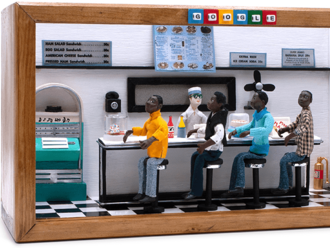Monitorujeme 1695 zdrojov

 Google Dooles 01.02.2020 05:43
Date: February 1, 2020
In honor of Black History Month, today’s diorama Doodle, created by Compton-based guest artist Karen Collins of the , remembers the Greensboro sit-in on its 60th anniversary. Organized by four Black college freshmen who became known as the “Greensboro Four,” this protest against segregation was a key part of the Civil Rights Movement, sparking a series of similar demonstrations throughout the nation.
Inspired by Dr. Martin Luther King, Jr.’s nonviolent protests for racial equality, North Carolina A&T State University freshmen Ezell Blair Jr. , David Richmond, Franklin McCain, and Joseph McNeil, met at the local Woolworth’s department store in Greensboro, North Carolina on this day in 1960. The group requested service at the “whites-only” lunch counter—a common discriminatory and segregation practice by US businesses and institutions allowed by Jim Crow era laws. Denied service, the four continued to peacefully occupy their seats and refused to leave until the store closed at night.
In the days and weeks that followed, the “Greensboro Four'' were joined by hundreds of other protesters. As the movement grew however, so too did the opposition, who routinely verbally harassed protesters with racial slurs—even resorting to spitting and throwing food at the nonviolent demonstrators. Undaunted, protestors were willing to repeat the sit-ins for as long as necessary, in hopes that the establishment would feel pressured to desegregate.
As a result of the movement’s passion and resilience, Woolworth's fully integrated their dining area on July 25th, 1960. Catalyzing a much larger nonviolent sit-in movement across the country, the protests played a definitive role in the fight for civil rights. In its wake, segregation of public places became illegal under the Civil Rights Act of 1964.
In recognition of this historic demonstration, the Woolworth’s Department Store in Greensboro is now the International Civil Rights Center and Museum, and part of the counter is housed at the Smithsonian National Museum of American History in Washington, D.C.
Guest Artist Q&A
Today’s Doodle was created by Compton-based guest artist Karen Collins of the . Below, she shares her thoughts behind the making of this Doodle:
Q: Why was this topic meaningful to you personally?
A: Creating art honoring the Greensboro sit-in is my way of giving back to today’s generation, especially to those who are in desperate times and troubles—to lift them up and teach them about their history.
Q: What does the Greensboro sit-in mean to you?
A: It was one of the sparks that led to national protest during the civil rights era for young people all over the country. It brought so many of us together to participate and stand up for our collective civil rights.
Q: How did you get started with dioramas?
A: They say, for artists, you have to see something ugly to create something beautiful. When tragedy hit my family, the anguish of what I could have done or should have done made me come up with the miniature museum, where I could draw from our history and share the positive perspective.
Q: What do you hope people take away from your Doodle?
A: I hope that everyone, especially young people, will go on to learn more about the sit-in and their personal histories as a whole. A lot of people sacrificed and died for the freedoms we enjoy today, and we should remember that and honor them. My goal is to show the strength of the people. We are not weak. We can keep going and strive to do better. One day I hope to open a physical space for all the museum’s dioramas so people and families of all backgrounds can come and learn about our history.
to learn more about Karen’s story and what inspired her to create today’s Doodle.
Photo Credit: Rebecca Veit
The Greensboro sit-in has been searched more than any other sit-in in U.S. Google Trends history. Explore more of America’s most searched moments at .
Location:
,
Tags:
,
,
,
,
,
,
Google Dooles 01.02.2020 05:43
Date: February 1, 2020
In honor of Black History Month, today’s diorama Doodle, created by Compton-based guest artist Karen Collins of the , remembers the Greensboro sit-in on its 60th anniversary. Organized by four Black college freshmen who became known as the “Greensboro Four,” this protest against segregation was a key part of the Civil Rights Movement, sparking a series of similar demonstrations throughout the nation.
Inspired by Dr. Martin Luther King, Jr.’s nonviolent protests for racial equality, North Carolina A&T State University freshmen Ezell Blair Jr. , David Richmond, Franklin McCain, and Joseph McNeil, met at the local Woolworth’s department store in Greensboro, North Carolina on this day in 1960. The group requested service at the “whites-only” lunch counter—a common discriminatory and segregation practice by US businesses and institutions allowed by Jim Crow era laws. Denied service, the four continued to peacefully occupy their seats and refused to leave until the store closed at night.
In the days and weeks that followed, the “Greensboro Four'' were joined by hundreds of other protesters. As the movement grew however, so too did the opposition, who routinely verbally harassed protesters with racial slurs—even resorting to spitting and throwing food at the nonviolent demonstrators. Undaunted, protestors were willing to repeat the sit-ins for as long as necessary, in hopes that the establishment would feel pressured to desegregate.
As a result of the movement’s passion and resilience, Woolworth's fully integrated their dining area on July 25th, 1960. Catalyzing a much larger nonviolent sit-in movement across the country, the protests played a definitive role in the fight for civil rights. In its wake, segregation of public places became illegal under the Civil Rights Act of 1964.
In recognition of this historic demonstration, the Woolworth’s Department Store in Greensboro is now the International Civil Rights Center and Museum, and part of the counter is housed at the Smithsonian National Museum of American History in Washington, D.C.
Guest Artist Q&A
Today’s Doodle was created by Compton-based guest artist Karen Collins of the . Below, she shares her thoughts behind the making of this Doodle:
Q: Why was this topic meaningful to you personally?
A: Creating art honoring the Greensboro sit-in is my way of giving back to today’s generation, especially to those who are in desperate times and troubles—to lift them up and teach them about their history.
Q: What does the Greensboro sit-in mean to you?
A: It was one of the sparks that led to national protest during the civil rights era for young people all over the country. It brought so many of us together to participate and stand up for our collective civil rights.
Q: How did you get started with dioramas?
A: They say, for artists, you have to see something ugly to create something beautiful. When tragedy hit my family, the anguish of what I could have done or should have done made me come up with the miniature museum, where I could draw from our history and share the positive perspective.
Q: What do you hope people take away from your Doodle?
A: I hope that everyone, especially young people, will go on to learn more about the sit-in and their personal histories as a whole. A lot of people sacrificed and died for the freedoms we enjoy today, and we should remember that and honor them. My goal is to show the strength of the people. We are not weak. We can keep going and strive to do better. One day I hope to open a physical space for all the museum’s dioramas so people and families of all backgrounds can come and learn about our history.
to learn more about Karen’s story and what inspired her to create today’s Doodle.
Photo Credit: Rebecca Veit
The Greensboro sit-in has been searched more than any other sit-in in U.S. Google Trends history. Explore more of America’s most searched moments at .
Location:
,
Tags:
,
,
,
,
,
,
NEWS.SK odporúča
Nie sú nájdené žiadne články.
Nie sú nájdené žiadne články.



















